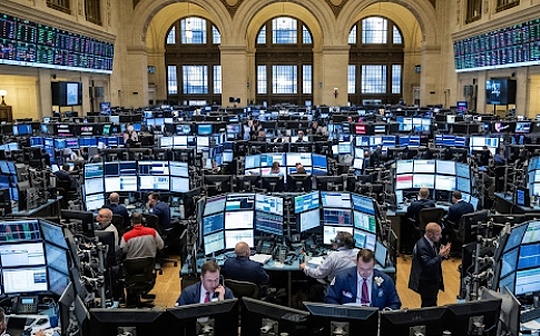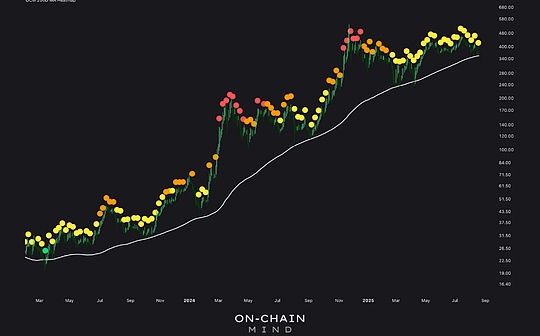
Preface
In the first half of this year, the US stock market ushered in a craze for listing in the cryptocurrency sector.After Trump took office for the second time, he signed an executive order for cryptocurrency, the Securities and Exchange Commission (SEC) From “law enforcement priority” to “cooperation-oriented”, a new crypto asset working group has been established, accelerating the listing of a series of high-quality cryptocurrency-related assets.FollowGalaxy Digital (GLXY),Circle(CRCL)After that, last week’s cryptocurrency exchangeBullish Exchangeand information service providersCoinDeskParent companyBullish(BLSH) also landed on the New York Stock Exchange.
Bullish with a good company name(English means bullish, bullish),Closed on the first day of listing84%, the current stock price is far higher thanIPOprice.Is it still worth investing in this position?Pan Du believes that compared to long-term holding,BullishMore suitable for short-term trading.BullishofIPOIssuance price (per share37USD) comparisonCoinbaseThe valuation is not too high, referring to the recent hotIPOThe market has sufficient short-term speculation space; however, the current stock price (as of8moon19Day, each share60USD) has reflected most of the upside of short-term speculation; taking into account another cryptocurrency exchangeGeminiAt8moon15Submitted on a dayIPOApply ifGeminiofIPOValuation relative toBullishMore“Cost-performance ratio” will drive speculative funds to rotate.Pan Du will explain in detail in this articleBullishfundamentals and valuation status.
1. Company profile and listing performance
Bullish, a global digital asset platform focusing on serving institutional investors, was officially listed on the New York Stock Exchange on August 13, 2025.Its listing process showed strong market attractiveness, and the final issue price was determined to be US$37, higher than the initial US$28-31, and exceeded the increase to US$32-33.The financing scale reached US$1.11 billion, with an overall valuation of US$5.41 billion, an increase of 29% from the initial valuation of US$4.2 billion.The IPO issuance scale is 30 million shares, an increase of 48% from the initial plan of 20.3 million shares.The subscription multiple exceeds 20 times, which is comparable to the previous subscription popularity of Circle.
It is worth noting that well-known institutions such as BlackRock and ARK Investment Management are interested in subscribing to a total of up to US$200 million in the IPO price range, accounting for about 20% of the issuance.This institutional endorsement is similar to the situation of Circle’s IPO, and Circle soared by 168% on the first day of listing.The lead underwriters of this IPO include internationally renowned investment banks such as JPMorgan Chase, Jefferies, and Citi.
2. Analysis of core business architecture
Bullish’s business system is mainly composed of two major sectors: Bullish Exchange and CoinDesk, forming a comprehensive ecosystem covering digital asset transactions and information services.
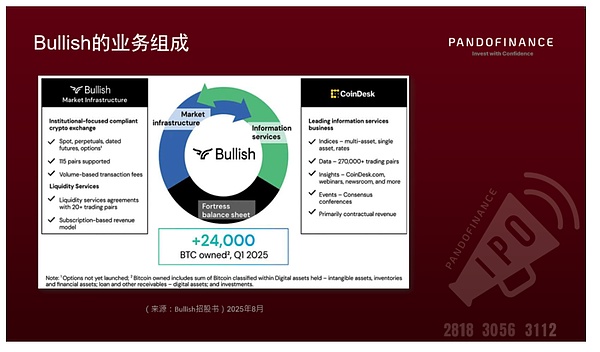
1) Bullish Exchange: Compliance-oriented transaction infrastructure
Among similar cryptocurrency exchanges, BullishIt is highly compliant, but the transaction volume and richness of trading products are in the middle.Bullish ExchangeOutstanding compliance, it has obtained regulatory licenses in many jurisdictions including the United States, Germany, Hong Kong and Gibraltar, and continues to promote license application in other regions.
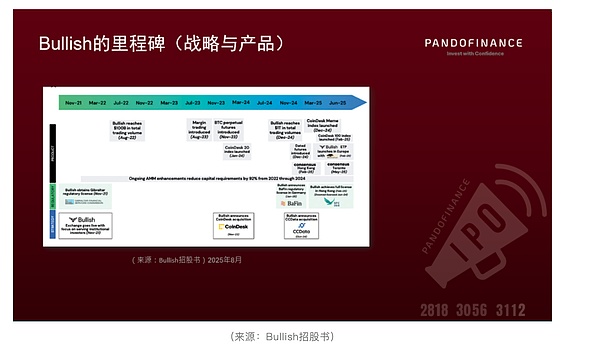
In terms of trading system, it adopts a single global order book model, covering spot, futures, margin trading, and provides supporting liquidity and settlement services.Judging from the transaction volume data, the total transaction volume of Bullish in 2024 reached US$546.7 billion, a year-on-year increase of 38%.However, if we compare Bullish with Coinbase, the leader of the compliant exchange, we can find that there is a huge gap in size among the two companies.During the same period, Coinbase’s trading volume was US$1.200 billion, a year-on-year growth rate of 148%.According to CoinMarketCap’s recent 24-hour platform transaction volume ranking, Bullish’s ranking lies between 10-15.
Bullish prospectus disclosed that its 24-year global spot trading volume market share is approximately US$284.8 billion and US$144.5 billion, respectively, accounting for 35% and 44% of similar exchanges.The advantages of this segmented trading field reflect the positioning of service institutional investors.From the perspective of trading price spreads, the downward trend is showing, reflecting the gradual fierce competition among trading platforms.In 1Q25, the average trading spread was 2.0 bps, a year-on-year decline of 47%.

Compared with leading platforms, there is also a certain gap in the richness of Bullish’s trading products.Currently, its spot trading pairs are more than 70 pairs and perpetual futures trading pairs are more than 45 pairs, far lower than the scale of hundreds of pairs on the leading platforms.Bullish currently has relatively single trading currencies for revenue, with Bitcoin and Ethereum accounting for 82% of its total trading volume, while this figure accounts for only 42% of Coinbase.
In terms of customer structure, the high concentration of institutional customers is its prominent feature.In the first quarter of 2025, the top five customers contributed 83% of adjusted trading revenue and 69% of spot trading volume. This highly concentrated customer structure not only reflects its positioning of serving institutional investors, but also brings certain customer dependence risks.
(II) CoinDesk: The benchmark for digital asset information services
As an information service sector under Bullish, CoinDesk mainly provides cryptocurrency-related value-added services such as index, data and insight, forming a diversified income model.Among them, the index business provides a series of tradable proprietary and single asset benchmark indexes to obtain revenue through licensing fees; the data business provides comprehensive digital asset market data and analysis services, with subscriptions and service fees as the main source of income; the insight business relies on the digital media platform Coindesk.com to achieve revenue through advertising, sponsorship and activities.
Judging from the operational data, this business segment has shown strong market influence.Coindesk.com’s total cumulative reach of more than 82 million in 2024; as of the second quarter of 2025, its index covered an asset management scale of US$41 billion, and the cumulative number of registered users at the Consensus Summit exceeded 26,000. These data demonstrate its leading position in the field of digital asset information services.
3. Benchmark analysis with Coinbase
Comparing Bullish with the industry’s leading platform Coinbase can help you better grasp its market positioning and competitive trend.

On the revenue side, Bullish’s year-on-year growth rate is slower than Coinbase.Although the trading volume gap with Coinbase is narrowing, the gap in trading revenue is widening due to the narrowing of Bullish trading price difference, which is worthy of attention.The revenue structure of the two is similar, with transaction revenue accounting for more than 60% of the total revenue, and the rest are mainly subscription and service revenue.
On the profit side, Bullish’s profit margin is far lower than Coinbase. The adjusted EBITDA profit margins in 24 years are 24% and 53%, respectively, which are different from the scale, operational capabilities, and the proportion of high-gross profit businesses.
Bullish recorded a loss in 1Q25, mainly due to the decline in cryptocurrency prices in the first quarter, resulting in a decline in the fair value of investments and digital assets; adjusted profit was US$2 million, a year-on-year decrease of 50%.The rebound of cryptocurrency prices in the second and third quarters will help boost profits.
4. Cryptocurrency held
As of June 30, 2025, Bullish held more than 20,000 Bitcoins and more than 10,000 Ethereum.Based on the market price on August 19, the market value is close to US$3 billion.
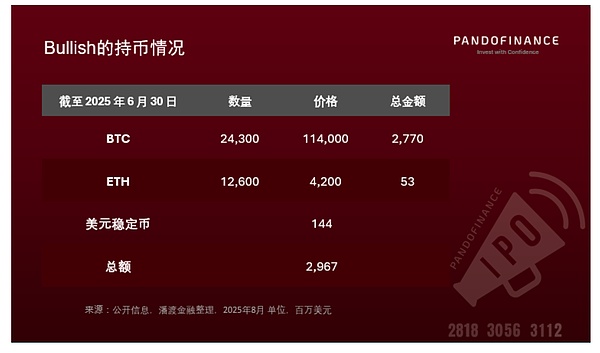
5. Shareholder background and management structure
Bullish’s shareholder lineup and management background provide important support for its development.Major shareholder Brendan Blumer, as co-founder and CEO of Block. One, holds a 28.1% stake after the IPO.Block. One launched EOS in 2017, becoming a dazzling new star in the cryptocurrency market at that time, but after fundraising, it experienced decline due to resource allocation and other issues.
Among early investors, Peter Thiel participated in the capital injection through Founders Fund and Thiel Capital, and served as a senior consultant in the early days of the company’s establishment. His influence in the field of technology and investment brought certain resources and attention to Bullish.However, its specific shareholding ratio and quantity have not been disclosed in public documents, and the proportion should be less than 5%.
In terms of management, current CEO Thomas Farley holds a 3.6% stake. He has served as the COO of the New York Stock Exchange Group and the president of the Intercontinental Exchange (ICE). His rich experience in traditional financial markets will help Bullish achieve breakthroughs in compliance operations and institutional cooperation.
6. Valuation analysis and investment logic
(I) Valuation level
Bullish is suitable for using the Division Total Valuation Method (SOTP), which separates core businesses (transactions, service subscriptions) from the cryptocurrency they hold.The market value of cryptocurrencies is close to US$3 billion. If the mNAV coefficient of listed companies (excluding pure coin hoarding companies) is taken from a range of 1.3 to 1.5, the corporate value of this part is about 4.2 billion yuan.For core business, you can refer to Coinbase’s EV / The revenue coefficient of the past fourth quarter is 11.1x, and a certain discount is attached.If calculated based on the calculation of close to 9x EV/Revenue, the corresponding enterprise value of Bullish’s core business is about 2 billion yuan.The combined total of about 6.2 billion yuan, while the current market value reflects the corporate value of about 8.6 billion yuan, reflecting the hot short-term IPO speculation sentiment, and the upward space has been mostly reflected in the stock price.
(II) Highlights of investment
-
The strong lineup of institutional investors and shareholders: there are some narrative points that can be hyped, which can also help expand institutional customers;
-
Asset reserves: Holding large quantities of mainstream cryptocurrencies such as Bitcoin is expected to bring significant fair value appreciation during the upward cycle of cryptocurrency prices.
(III) Risk factors
-
Business concentration risk: Bitcoin and Ethereum transactions account for too high, the concentration of leading customers is high, and changes in single asset prices or customer resources will have a greater impact on the company.
-
Profit volatility: greatly affected by the cryptocurrency market.Losses caused by market decline in the first quarter of 2025 are typical cases.
-
Industry competition is intensifying: transaction spreads continue to narrow, compressing profit margins, and also facing dual pressure from leading platforms and emerging competitors.For example, new cryptocurrency exchange IPOs such as Gemini will also have an impact on existing valuations.


